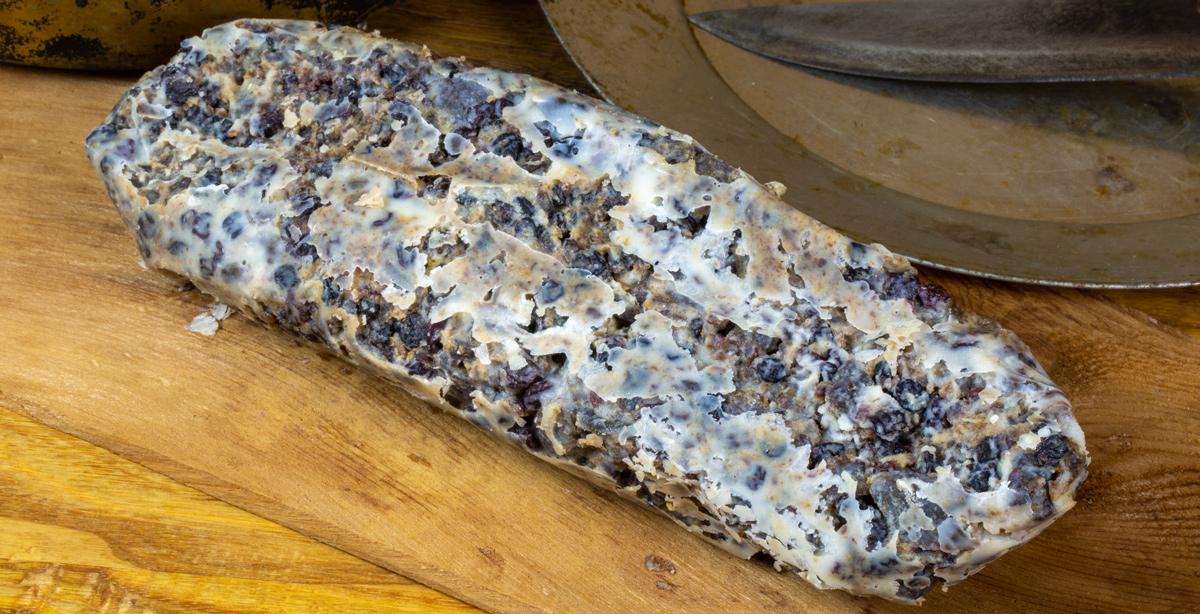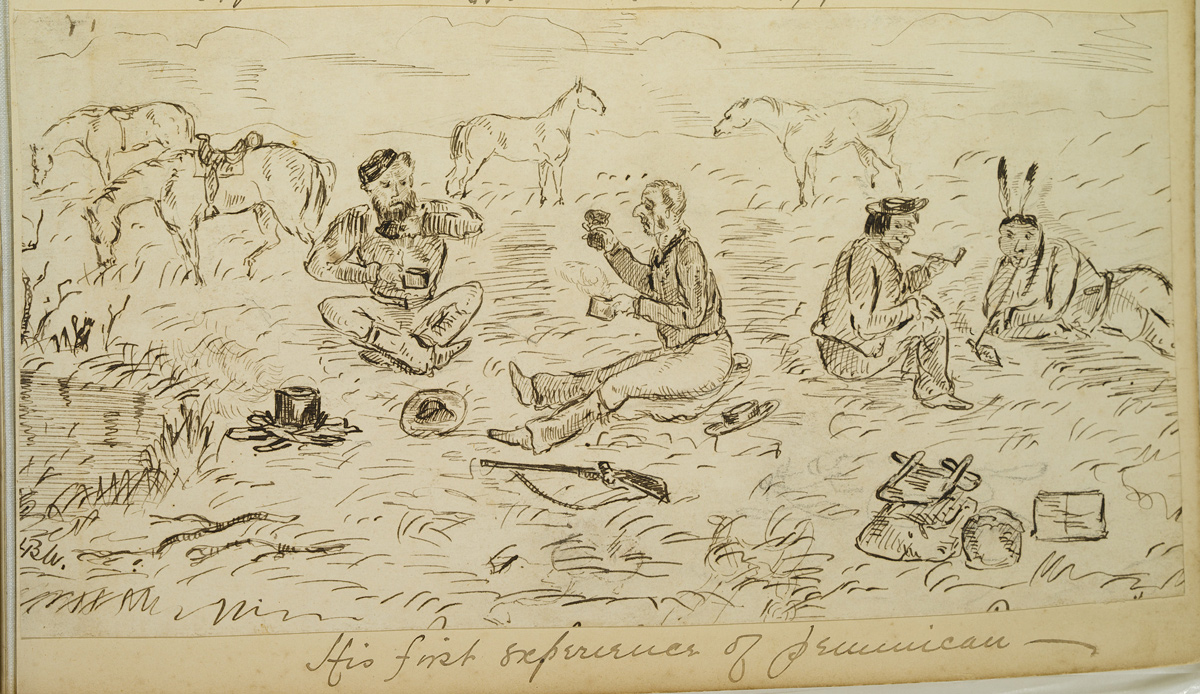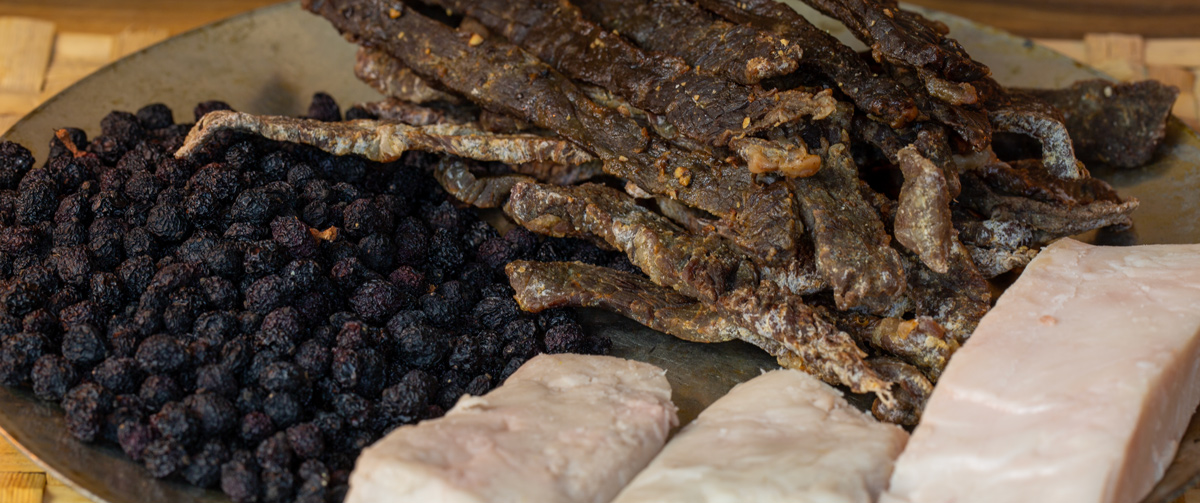Figure 1
Pemmican
© 2020 Kristopher K. Townsend. Permission to use granted under the Creative Commons Attribution-Share Alike 4.0 International license.
For thousands of years, pemmican—dried meat, rendered fat, and sometimes dried berries—was a staple food of North American Indians, especially the northern tribes. The word itself comes from the Cree language meaning “manufactured grease.”[1]Edward N. Wentworth, “Dried Meat—Early Man’s Travel Ration,” Agricultural History 30 (January 1956): 2-10. Those employed in the fur trade were quick to utilize pemmican. The meat ingredient could be any available game, but typically was buffalo. A single buffalo provided the meat, fat, and hide bag used to compress and store approximately 100 pounds pemmican. Edward Wentworth describes its use:
This species of food is invaluable as a travelling provision. There is no risk of spoiling it as, if ordinary care be taken to keep the bags dry and free from mould, there is no assignable limit to the time the pemmican will keep. It is the travelling provision used throughout the north, where, in addition to the already specified qualifications, that of its great facility of transportation renders it exceedingly useful.[2]Wentworth.
Entire factories developed around the production of pemmican. Most notably Red River Métis would make pemmican and ship the heavy bags in Red River carts for storage at major northern trading posts. So advanced had this industry become that by 1814, control of the Red River trade became a political weapon between competing North West and Hudson’s Bay companies leading to the Pemmican War[3]For more about the Red River carts and trading trails, see Barbara Huck, et al. Exploring the Fur Trade Routes of North America (Winnipeg, Heartland, 2002), 202–203 and “Pemmican War”, … Continue readingand the Pemmican Trials of 1818.[4]See Andrew Amos, Report of Trials in the Courts of Canada, Relative to the Destruction of the Earl of Selkirk’s Settlement on the Red River With Observations (London: John Murray, 1820) … Continue reading
Making and Eating Pemmican
Pemmican works well in northern climates. The fat provides essential calories, seals the meat from penetrating bacteria,[5]Leandra Zim Holland, Feasting and Fasting with Lewis & Clark: A Food and Social History of the Early 1800s (Emigrant, Montana: Old Yellowstone Publishing, 2003), 12. and does not freeze. Marrow and dried berries were only sometimes added, and most sources say fur traders preferred their pemmican without berries. This makes sense when looking at how pemmican was actually eaten—most often cooked with other ingredients and rarely eaten raw.
During the fur trade, pemmican was most often made by killing the buffalo, jerking the meat, making hair-out bags from its hide, and rendering tallow from the animal’s marrow, suet, or fat. The dried meat was then broken up by pounding. The liquid fat was added in equal measure and:
[T]he mixture was poured hot into bags of buffalo hide holding a hundred pounds, compressed as it cooled, and the bags sewn shut. After cooling completely the pemmican was so hard that a sharp blow was necessary to break off a fragment It was eaten cold or used with vegetables or roots in a stew.”[6]Joseph Kinsey Howard, Strange Empire: A Narrative of the Northwest (New York: William Morrow and Company, 1952), 305.
Pemmican was made more palatable by adding it to stews or frying it with vegetables.[7]Samuel B. Steele, Forty Years in Canada: Reminiscences of the Great North-West (New York: Dodd, Mead & Company, 1915), 69–70 Adding berries, in the opinion of the machismo fur trade worker, was a fancy preference of their Indian wives.[8]Wentworth, 6. There is no doubt the fruit’s sweetness helps cut through the taste of desiccated meat and rendered fat. Eating pemmican raw must have been considered a bit rough, at least as indicated by the two Indians in the figure laughing as the greenhorn trappers taste their first pemmican.
Pemmican in the Journals
Lakota Sioux Feast
Pemmican first appears in the journals when the Lakota Sioux hosted a feast for the captains to ease tensions after an earlier standoff—see Lakota Sioux Difficulties by James P. Ronda. With the help of Nicholas Biddle‘s 1814 paraphrase, Clark’s description of the meal becomes clear:
We smoked, and he again harangued his people, after which the repast was served up to us. It consisted of the dog which they had just been cooking, this being a great dish among the Sioux, and used on all festivals; to this were added, pemitigon [pemmican], a dish made of buffalo meat, dried or jerked, and then pounded and mixed raw with grease and a kind of ground potato, dressed like the preparation of Indian corn called hominy, to which it is little inferior. Of all these luxuries which were place before us in platters with horn spoons, we took the pemitigon and the potato, which we found good, but we could as yet partake but sparingly of the dog.[9]Nicholas Biddle, Ed., History of the Expedition Under the Command of Captains Lewis and Clark to the sources of the Missouri and thence across the Rocky Mountains and down the River Columbia to the … Continue reading
Falls of the Missouri Portage
All three dishes, Indian root vegetables, jerked meat, and dog would become essential nutrition as the expedition crossed the continent and returned home. Pemmican was attempted, but only when they had the essential ingredients and the time required to fully dry the meat and hides and render fat. During the portage of the Great Falls of the Missouri, the conditions for making pemmican were as good as they would ever be.
During the portage, there were often so many buffalo that the plains turned black. To cover the iron-framed boat, Drouillard and other hunters harvested numerous buffalo for their skins. Several men at Upper Portage Camp were busy rendering tallow, and Toussaint Charbonneau had been rendering tallow at Lower Portage Camp. On 3 July 1805, Clark simply states:
others hunting for Meet to make pemitigon & for the use of their Skins to Cover the Canoes & boat,—.
—Clark, 3 July 1805
With the portage complete and the leaky iron-framed boat disassembled and cached, Clark had moved operations to a canoe camp several miles upriver near present-day Ulm, Montana. Apparently, the pemmican-making operation continued there:
The Hunters killed 3 Buffalow the most of all the meat I had dried for to make Pemitigon.
—Clark, 13 July 1805
Damp Times in the Pacific Northwest
While paddling up the Columbia in spring 1806, the expedition stopped for several days at “Provision Camp” to explore the Sandy River and prepare a large store of meat before continuing. An attempt to make pemmican is inferred when Clark describes the frustration in making the bags and not being able to pound their meat. He lamented:
The dear skins which we had cased for the purpose of holding our dried meat is not Sufficently dry for that purpose, we derected them to be dried by the fire also. the weather being So damp that there was no possibullity of pounding the meat as I wished.
—Clark, 13 July 1805
Making pemmican was typically done in the summer, not the spring. Here, the captains lacked the time to wait for dryer weather so that they could fully dry and then pound the jerky to make pemmican.
Recipe
Figure 3
Ingredients
© Kristopher K. Townsend. Permission to use granted under the Creative Commons Attribution-Share Alike 4.0 International license.
Above: a portion of the ingredients used to make the pemmican in Figure 1: dried Zante currants, buffalo jerky, and beef suet. Zante currants are actually Black Corinth grapes—not the currants that grow wild along much of the Lewis and Clark trail. Outside the United States, Zante currants are simply called currants.[10]For more, see “Zante currant, Wikpedia, accessed 23 October 2020, https://en.wikipedia.org/wiki/Zante_currant.
Ingredients
- Jerky, 1 to 3 pounds, fully dried (see Jerking Meat)
- Melted suet, 1 to 3 pounds (see “Render the Tallow” in Making Candles)
- Dried berries, ½ cup per pound of meat (optional)
If you plan to eat your pemmican raw, add the dried berries and make only small quantity—you probably won’t want to eat much of it.
Cooking
- Break up the jerky in a food processor
- Spread the broken pieces over a large, shallow pan.
- Pour the liquid tallow completely covering the jerky.
- Cool until the mixture can be safely handled, but still warm.
- Pour into a gallon re-sealable gallon-sized bag. Roll the mixture in the bag compressing the mixture while removing most of the air from the bag, and then seal the bag. See Figure 1.
- While still compressed, let cool completely.
Eating
Complete the experience by sampling the raw pemmican. Then, use it as a base for a stew with potatoes of fried with onions.
A Durable Survival Food
Given the efficacy of pemmican, it should be no surprise that fur traders, explorers, and armies utilized it throughout the world. The term was introduced to European-based society after Alexander Mackenzie‘s northern cross-continental exploration in 1793, and the word first appeared in print in the 1801 Oxford Dictionary as learned from that explorer. The first American source in print was from Clark, with the assistance of Nicholas Biddle as quoted above. Other northern explorers who relied on pemmican were Robert Peary, North Pole, 1886 to 1909 and Ernest Shackleton, Antarctica, 1914–1916. [11]“Pemmican,” Wikpedia, accessed on 22 October 2020, https://en.wikipedia.org/wiki/Pemmican. The US Army studied pemmican’s usefulness as a survival food as late as 1961.[12]“Arctic Survival Rations, III. The Evaluation of Pemmican Under Winter Field Conditions,” in “Pemmican,” Nutrition Reviews, Volume 19, Issue 3, March 1961, Pages 73–75, … Continue reading Modern refrigeration and today’s more sedentary lifestyles have eliminated the role of pemmican as a survival food. Nevertheless, making and eating pemmican is one way to experience and respect a rich history of North American lifeways.
Notes
| ↑1 | Edward N. Wentworth, “Dried Meat—Early Man’s Travel Ration,” Agricultural History 30 (January 1956): 2-10. |
|---|---|
| ↑2 | Wentworth. |
| ↑3 | For more about the Red River carts and trading trails, see Barbara Huck, et al. Exploring the Fur Trade Routes of North America (Winnipeg, Heartland, 2002), 202–203 and “Pemmican War”, Wikpedia, accessed 21 October 2020, https://en.wikipedia.org/wiki/Pemmican_War. |
| ↑4 | See Andrew Amos, Report of Trials in the Courts of Canada, Relative to the Destruction of the Earl of Selkirk’s Settlement on the Red River With Observations (London: John Murray, 1820) retrieved 21 October 2020, http://peel.library.ualberta.ca/bibliography/113/2.html. |
| ↑5 | Leandra Zim Holland, Feasting and Fasting with Lewis & Clark: A Food and Social History of the Early 1800s (Emigrant, Montana: Old Yellowstone Publishing, 2003), 12. |
| ↑6 | Joseph Kinsey Howard, Strange Empire: A Narrative of the Northwest (New York: William Morrow and Company, 1952), 305. |
| ↑7 | Samuel B. Steele, Forty Years in Canada: Reminiscences of the Great North-West (New York: Dodd, Mead & Company, 1915), 69–70 |
| ↑8 | Wentworth, 6. |
| ↑9 | Nicholas Biddle, Ed., History of the Expedition Under the Command of Captains Lewis and Clark to the sources of the Missouri and thence across the Rocky Mountains and down the River Columbia to the Pacific Ocean. Performed during the years 1804–5–6. By order of the Government of the United States (New York: The Heritage Press, 1962), 53. |
| ↑10 | For more, see “Zante currant, Wikpedia, accessed 23 October 2020, https://en.wikipedia.org/wiki/Zante_currant. |
| ↑11 | “Pemmican,” Wikpedia, accessed on 22 October 2020, https://en.wikipedia.org/wiki/Pemmican. |
| ↑12 | “Arctic Survival Rations, III. The Evaluation of Pemmican Under Winter Field Conditions,” in “Pemmican,” Nutrition Reviews, Volume 19, Issue 3, March 1961, Pages 73–75, https://doi.org/10.1111/j.1753-4887.1961.tb01895.x. |



